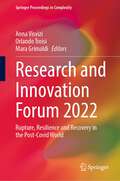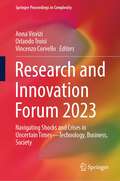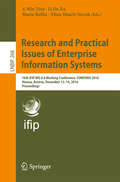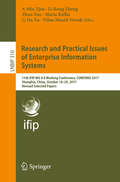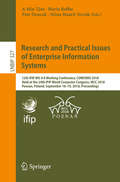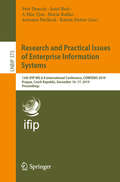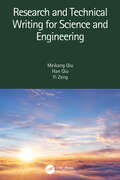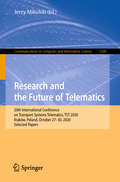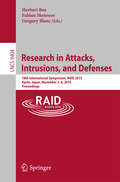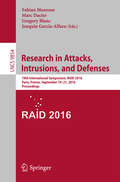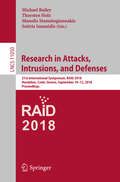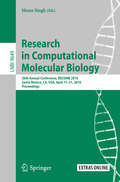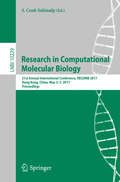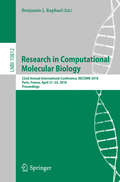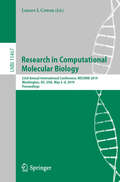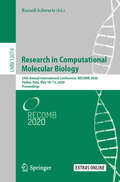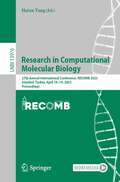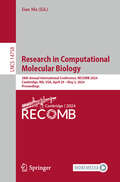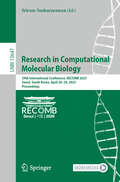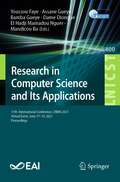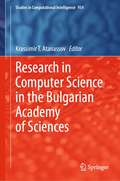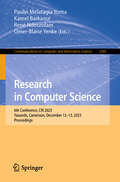- Table View
- List View
Research and Innovation Forum 2022: Rupture, Resilience and Recovery in the Post-Covid World (Springer Proceedings in Complexity)
by Anna Visvizi Orlando Troisi Mara GrimaldiThis book features research presented and discussed during the Research & Innovation Forum (Rii Forum) 2022. As such, this book offers a unique insight into emerging topics, issues and developments pertinent to the fields of technology, innovation and education and their social impact. Papers included in this book apply inter- and multi-disciplinary approaches to query such issues as technology-enhanced teaching and learning, smart cities, information systems, cognitive computing and social networking. What brings these threads of the discussion together is the question of how advances in computer science – which are otherwise largely incomprehensible to researchers from other fields – can be effectively translated and capitalized on so as to make them beneficial for society as a whole. In this context, Rii Forum and Rii Forum proceedings offer an essential venue where diverse stakeholders, including academics, the think tank sector and decision-makers, can engage in a meaningful dialogue with a view to improving the applicability of advances in computer science.
Research and Innovation Forum 2023: Navigating Shocks and Crises in Uncertain Times—Technology, Business, Society (Springer Proceedings in Complexity)
by Anna Visvizi Orlando Troisi Vincenzo CorvelloThis book features research presented and discussed during the Research & Innovation Forum (Rii Forum) 2023. As such, this book offers a unique insight into emerging topics, issues and developments pertinent to the fields of technology, innovation and education and their social impact. Papers included in this book apply inter- and multi-disciplinary approaches to query such issues as technology-enhanced teaching and learning, smart cities, information systems, cognitive computing and social networking. What brings these threads of the discussion together is the question of how advances in computer science—which are otherwise largely incomprehensible to researchers from other fields—can be effectively translated and capitalized on so as to make them beneficial for society as a whole. In this context, Rii Forum and Rii Forum proceedings offer an essential venue where diverse stakeholders, including academics, the think tank sector and decision-makers, can engage in a meaningful dialogue with a view to improving the applicability of advances in computer science.
Research and Practical Issues of Enterprise Information Systems
by A Min Tjoa Li Da Xu Maria Raffai Niina Maarit NovakThis book constitutes the proceedings of the 10th International IFIP WG 8. 9 Working Conference on Research and Practical Issues of Enterprise Information Systems, CONFENIS 2016, held in Vienna, Austria, in December 2016. The conference provided an international forum for the broader IFIP community to discuss the latest research findings in the area of EIS and specifically aimed at facilitating the exchange of ideas and advances on all aspects and developments of EIS. The 25 papers presented in this volume were carefully reviewed and selected from 63 submissions. They were organized in topical sections on: semantic concepts and open data; customer relationship management; security and privacy issues; advanced manufacturing and management aspects; business intelligence and big data; decision support in EIS; and EIS-practices.
Research and Practical Issues of Enterprise Information Systems: 11th IFIP WG 8.9 Working Conference, CONFENIS 2017, Shanghai, China, October 18-20, 2017, Revised Selected Papers (Lecture Notes in Business Information Processing #310)
by A Min Tjoa Li Da Xu Maria Raffai Niina Maarit Novak Li-Rong Zheng Zhuo ZouThis book constitutes the refereed proceedings of the 11th IFIP WG 8.9 Working Conference on Research and Practical Issues of Enterprise Information Systems, CONFENIS 2017, held in Shanghai, China, in October 2017. The 17 full papers presented in this volume were carefully reviewed and selected from 39 submissions. They were organized in topical sections named: EIS concepts, theory and methods; IoT and emerging paradigm; EIS for industry 4.0; big data analytics; and intelligent electronics and systems for industrial IoT.
Research and Practical Issues of Enterprise Information Systems: 12th IFIP WG 8.9 Working Conference, CONFENIS 2018, Held at the 24th IFIP World Computer Congress, WCC 2018, Poznan, Poland, September 18–19, 2018, Proceedings (Lecture Notes in Business Information Processing #327)
by A Min Tjoa Maria Raffai Niina Maarit Novak Petr DoucekThis book constitutes the refereed proceedings of the 12th IFIP WG 8.9 Working Conference on Research and Practical Issues of Enterprise Information Systems, CONFENIS 2018, held as part of the World Computer Congress, WCC 2018, in Poznan, Poland, in September 2018. The 12 full papers presented in this volume were carefully reviewed and selected from 28 submissions. They were organized in topical sections named: EIS management and case studies; data management and applications for EIS; collaborative and social interaction; and data access, security, and privacy.
Research and Practical Issues of Enterprise Information Systems: 13th IFIP WG 8.9 International Conference, CONFENIS 2019, Prague, Czech Republic, December 16–17, 2019, Proceedings (Lecture Notes in Business Information Processing #375)
by A Min Tjoa Maria Raffai Petr Doucek Josef Basl Antonin Pavlicek Katrin DetterThis book constitutes the refereed proceedings of the 13th IFIP WG 8.9 Working Conference on Research and Practical Issues of Enterprise Information Systems, CONFENIS 2019, held in Prague, Czech Republic, in December 2019. The 11 full and 2 short papers included in this volume were carefully reviewed and selected from 43 submissions. They were organized in topical sections named: EIS and industry; technical architecture and applications for EIS; collaborative networks and project management; and security and privacy issues.
Research and Technical Writing for Science and Engineering
by Yi Zeng Meikang Qiu Han QiuEngineering and science research can be difficult for beginners because scientific research is fraught with constraints and disciplines. Research and Technical Writing for Science and Engineering breakdowns the entire process of conducting engineering and scientific research. This book covers those fascinating guidelines and topics on conducting research, as well as how to better interact with your advisor. Key Features: advice on conducting a literature review, conducting experiments, and writing a good paper summarizing your findings. provides a tutorial on how to increase the impact of research and how to manage research resources. By reflecting on the cases discussed in this book, readers will be able to identify specific situations or dilemmas in their own lives, as the authors provide comprehensive suggestions based on their own experiences.
Research and the Future of Telematics: 20th International Conference on Transport Systems Telematics, TST 2020, Kraków, Poland, October 27-30, 2020, Selected Papers (Communications in Computer and Information Science #1289)
by Jerzy MikulskiThis book constitutes selected papers from the 20th International Conference on Transport Systems Telematics, TST 2020, held in Kraków, Poland, in October 2020. The 34 full papers presented in this volume were carefully reviewed and selected from 97 submissions. They were organized in topical sections named: telematics in road transport - general view; telematics in road transport - details in applications.- telematics in rail and marine transport; general about telematics.
Research in Attacks, Intrusions, and Defenses
by Herbert Bos Fabian Monrose Gregory BlancThis book constitutes the refereed proceedings of the 18th International Symposium on Research in Attacks, Intrusions and Defenses, RAID 2015, held in Kyoto, Japan, in November 2015. The 28 full papers were carefully reviewed and selected from 119 submissions. This symposium brings together leading researchers and practitioners from academia, government, and industry to discuss novel security problems, solutions, and technologies related to intrusion detection, attacks, and defenses.
Research in Attacks, Intrusions, and Defenses
by Joaquin Garcia-Alfaro Fabian Monrose Gregory Blanc Marc DacierThis book constitutes the refereed proceedings of the 18th International Symposium on Research in Attacks, Intrusions and Defenses, RAID 2015, held in Kyoto, Japan, in November 2015. The 28 full papers were carefully reviewed and selected from 119 submissions. This symposium brings together leading researchers and practitioners from academia, government, and industry to discuss novel security problems, solutions, and technologies related to intrusion detection, attacks, and defenses.
Research in Attacks, Intrusions, and Defenses
by Michael Bailey Michalis Polychronakis Marc Dacier Manos AntonakakisThis book constitutes the refereed proceedings oft he 19th International Symposium on Research in Attacks, Intrusions, and Defenses, RAID 2016, held in Evry, France, in September 2016. The 21 full papers presented were carefully reviewed and selected from 85 submissions. They are organized around the following topics: systems security; low-level attacks and defenses; measurement studies; malware analysis; network security; systematization of knowledge and experience reports; Web and mobile security.
Research in Attacks, Intrusions, and Defenses: 21st International Symposium, RAID 2018, Heraklion, Crete, Greece, September 10-12, 2018, Proceedings (Lecture Notes in Computer Science #11050)
by Michael Bailey Sotiris Ioannidis Thorsten Holz Manolis StamatogiannakisThis book constitutes the refereed proceedings of the 21st International Symposium on Research in Attacks, Intrusions, and Defenses, RAID 2018, held in Heraklion, Crete, Greece, in September 2018.The 32 revised full papers were carefully reviewed and selected from 145 submissions. They are organized in the following topical sections: attacks; intrusion detection and prevention; DDoS attacks; passwords, accounts, and users; machine learning for computer security; hardware-assisted security; software security; malware; IoT/CPS security; security measurements; and defenses.
Research in Computational Molecular Biology
by Mona SinghThisbook constitutes the proceedings of the 20th Annual Conference on Research inComputational Molecular Biology, RECOMB 2016, held in Santa Monica, CA, USA, inApril 2016. The 15 regular papers presented in this volume were carefullyreviewed and selected from 172 submissions. 20 short abstracts are included inthe back matter of the volume. They report on original research in all areas ofcomputational molecular biology and bioinformatics.
Research in Computational Molecular Biology
by S. Cenk SahinalpThis book constitutes the refereed proceedings of the 15th Annual International Conference on Research in Computational Molecular Biology, RECOMB 2011, held in Vancouver, Canada, in March 2011. The 43 revised full papers were carefully reviewed and selected from 153 submissions. The papers cover a wide range of topics including molecular sequence analysis; recognition of genes and regulatory elements; molecular evolution; gene expression; biological networks; sequencing and genotyping technologies; genomics; population, statistical genetics; systems biology; imaging; computational proteomics; molecular structural biology.
Research in Computational Molecular Biology: 22nd Annual International Conference, RECOMB 2018, Paris, France, April 21-24, 2018, Proceedings (Lecture Notes in Computer Science #10812)
by Benjamin J. RaphaelThis book constitutes the proceedings of the 22nd Annual Conference on Research in Computational Molecular Biology, RECOMB 2018, held in Paris, France, in April 2018.The 16 extended and 22 short abstracts presented were carefully reviewed and selected from 193 submissions. The short abstracts are included in the back matter of the volume. They report on original research in all areas of computational molecular biology and bioinformatics.
Research in Computational Molecular Biology: 23rd Annual International Conference, RECOMB 2019, Washington, DC, USA, May 5-8, 2019, Proceedings (Lecture Notes in Computer Science #11467)
by Lenore J. CowenThis book constitutes the proceedings of the 23rd Annual Conference on Research in Computational Molecular Biology, RECOMB 2019, held in Washington, DC, USA, in April 2019. The 17 extended and 20 short abstracts presented were carefully reviewed and selected from 175 submissions. The short abstracts are included in the back matter of the volume. The papers report on original research in all areas of computational molecular biology and bioinformatics.
Research in Computational Molecular Biology: 24th Annual International Conference, RECOMB 2020, Padua, Italy, May 10–13, 2020, Proceedings (Lecture Notes in Computer Science #12074)
by Russell SchwartzThis book constitutes the proceedings of the 24th Annual Conference on Research in Computational Molecular Biology, RECOMB 2020, held in Padua, Italy, in May 2020. The 13 regular and 24 short papers presented were carefully reviewed and selected from 206 submissions. The papers report on original research in all areas of computational molecular biology and bioinformatics.
Research in Computational Molecular Biology: 26th Annual International Conference, RECOMB 2022, San Diego, CA, USA, May 22–25, 2022, Proceedings (Lecture Notes in Computer Science #13278)
by Itsik Pe’erThis book constitutes the proceedings of the 26th Annual Conference on Research in Computational Molecular Biology, RECOMB 2022, held in San Diego, CA, USA in May 2022. The 17 regular and 23 short papers presented were carefully reviewed and selected from 188 submissions. The papers report on original research in all areas of computational molecular biology and bioinformatics.
Research in Computational Molecular Biology: 27th Annual International Conference, RECOMB 2023, Istanbul, Turkey, April 16–19, 2023, Proceedings (Lecture Notes in Computer Science #13976)
by Haixu TangThis book constitutes the refereed proceedings of the 27th Annual International Conference on Research in Computational Molecular Biology, RECOMB 2023, held in Istanbul, Turkey, during April 16–19, 2023.The 11 regular and 33 short papers presented in this book were carefully reviewed and selected from 188 submissions. The papers report on original research in all areas of computational molecular biology and bioinformatics.
Research in Computational Molecular Biology: 28th Annual International Conference, RECOMB 2024, Cambridge, MA, USA, April 29–May 2, 2024, Proceedings (Lecture Notes in Computer Science #14758)
by Jian MaThis book constitutes the proceedings of the 28th Annual International Conference on Research in Computational Molecular Biology, RECOMB 2024, held in Cambridge, MA, USA, during April 29–May 2, 2024. The 57 full papers included in this book were carefully reviewed and selected from 352 submissions. They were organized in topical sections as follows: theoretical and foundational algorithm contributions and more applied directions that engage with new technologies and intriguing biological questions.
Research in Computational Molecular Biology: 29th International Conference, RECOMB 2025, Seoul, South Korea, April 26–29, 2025, Proceedings (Lecture Notes in Computer Science #15647)
by Sriram SankararamanThis book constitutes the proceedings of the 29th Annual International Conference on Research in Computational Molecular Biology, RECOMB 2025, held in Seoul, South Korea, during April 26–29, 2025. The 14 full papers and 41 short papers were carefully reviewed and selected from 339 submissions. They focus on advances in computational biology and applications in molecular biology and medicine. The conference aims at bridging the computational, mathematical, statistical, and biological sciences, and bringing together researchers, professionals, students and industrial practitioners from all over the world for interaction and exchange of new developments in all areas of bioinformatics and computational biology.
Research in Computer Science and Its Applications: 11th International Conference, CNRIA 2021, Virtual Event, June 17-19, 2021, Proceedings (Lecture Notes of the Institute for Computer Sciences, Social Informatics and Telecommunications Engineering #400)
by Assane Gueye Youssou Faye Bamba Gueye Dame Diongue El Hadji Mamadou Nguer Mandicou BaThis book constitutes the refereed post-conference proceedings of the 11th EAI International Conference on Research in Computer science and its Applications, CNRIA 2021, held in June 2021. Due to COVID-19 pandemic the conference was held virtually. The 11 full papers presented were selected from 24 submissions and issue different problems in underserved and unserved areas. The papers are arranged in 3 tracks: data science and artificial intelligence; telecom and artificial intelligence; IoT and ICT applications.
Research in Computer Science in the Bulgarian Academy of Sciences (Studies in Computational Intelligence #934)
by Krassimir T. AtanassovThis book is a collection of papers devoted to the emergence and development in Bulgarian Academy of Sciences of some of the areas of informatics, including artificial intelligence. The papers are prepared by specialists from the Academy, some of whom are among the founders of these scientific and application areas in Bulgaria and in some cases – in the world. The book is interesting for specialists in informatics and computer science and researchers in history of sciences.
Research in Computer Science: 17th African Conference on Research in Computer Science and Applied Mathematics, CARI 2024, Bejaïa, Algeria, November 24–26, 2024, Proceedings (Communications in Computer and Information Science #2462)
by Kamel Barkaoui Mathieu Roche Djamil AissaniThis book constitutes the refereed proceedings of the 17th African Conference on Research in Computer Science and Applied Mathematics, CARI 2024, in Bejaïa, Algeria, in November 23-26, 2024. The 25 full papers included in this book were carefully reviewed and selected from 90 submissions. The conference covers a range of subjects, including optimization and heuristics, cluster analysis, reactive systems, information security, natural language and speech processing, computer Vision and image processing, machine learning and deep learning.
Research in Computer Science: 6th Conference, CRI 2023, Yaounde, Cameroon, December 12–13, 2023, Proceedings (Communications in Computer and Information Science #2085)
by Kamel Barkaoui Paulin Melatagia Yonta René Ndoundam Omer-Blaise YenkeThis book constitutes the refereed proceedings of the 6th Conference on Research in Computer Science, CRI 2023, held in Yaounde, Cameroon, during December 12-13, 2023. The 16 full papers included in this book were carefully reviewed and selected from 72 submissions. The CRI 2023 proceedings focus on artificial intelligence, machine learning, natural language processing, computer vision, cryptography and distributed computing.
